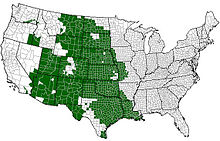Woodhouse's toad
| Woodhouse's toad | |
|---|---|
 |
|
| Scientific classification | |
| Kingdom: | Animalia |
| Phylum: | Chordata |
| Class: | Amphibia |
| Order: | Anura |
| Family: | Bufonidae |
| Genus: | Anaxyrus |
| Species: | A. woodhousii |
| Binomial name | |
|
Anaxyrus woodhousii (Girard, 1854) |
|
 |
|
| United States range of A. woodhousii | |
| Synonyms | |
|
Bufo woodhousii Girard, 1854 |
|
Bufo woodhousii Girard, 1854
Woodhouse's toad (Anaxyrus woodhousii) is a medium-sized (4 inches or 10 centimetres) true toad native to the United States and Mexico. There are three recognized subspecies. A. woodhousii tends to hybridize with Anaxyrus americanus where their ranges overlap.
Woodhouse's toad was first described in 1854 by the French herpetologist Charles Frédéric Girard. He gave it the name Bufo woodhousii in honor of the American physician and naturalist Samuel Washington Woodhouse. The large genus Bufo was split by Frost et al. in 2006, with the North American species being included in the genus Anaxyrus and this toad becoming A. woodhousii. There are three recognised subspecies:
At one time, Fowler's toad (Anaxyrus fowleri) was considered to be a subspecies.
Woodhouse's toad is a robust amphibian and can grow to a maximum snout-vent length of 127 mm (5 in). The head has prominent cranial crests in front of and in between the eyes. The parotoid glands are long and large. The dorsal surface of this toad is grayish-brown or yellowish-brown and it is speckled with small dark spots. There is a narrow pale line running along the spine. The belly is rather paler and is usually unspotted. The male has a single vocal sac on his throat. His call resembles the bleat of a sheep and lasts from one to three seconds.
Woodhouse's toad is found in North America at altitudes of up to 2,500 metres (8,200 ft). Its range extends from Mexico in the south to Washington in the north. In the United States it is found in Arizona, California, Colorado, Idaho, Kansas, Montana, Nebraska, Nevada, New Mexico, North Dakota, Oklahoma, Oregon, South Dakota, Texas, Utah and Washington. In the western part of its range it is typically found in lowland riparian corridors, wooded land besides streams and rivers. At higher altitudes it inhabits wet meadows, ponds, reservoirs and lakes. It is also found in urban environments, canals, ponds and irrigated agricultural land.
...
Wikipedia

